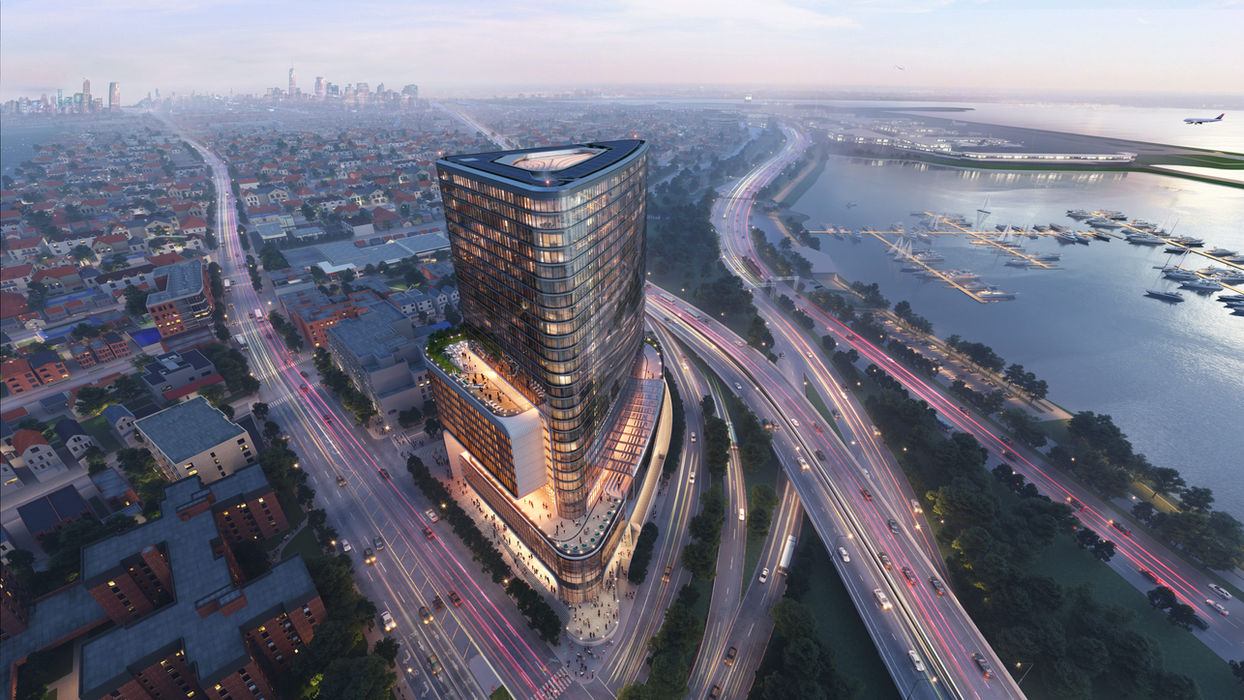About Justice Unfrozen
Justice Unfrozen is a platform built to expose how the SEC — under the guise of investor protection — dismantled two groundbreaking real estate projects, froze the futures of over 450 immigrant families, and buried critical evidence to protect its narrative.
This is not just a legal case. It is a cautionary tale of what happens when unchecked power collides with immigrant ambition, innovation, and the American Dream. We stand to reveal the full truth behind SEC v. Xia, demand accountability, and fight for justice — not just in the courtroom, but in the court of public opinion.
The facts are here. The voices are real. The harm is undeniable. It’s time to unfreeze justice.
Timeline of Events
They Built the Future — Until the SEC Tore It Down
2010
Richard Xia begins two transformative development projects in Queens, NY — Eastern Mirage and Eastern Emerald— focused on net-zero carbon design and smart technologies. Planning and early-stage outreach begin.
2011–2014
Eastern Mirage site is acquired. In June 2014, the project receives formal approval from the NYC Board of Standards and Appeals, clearing the way for construction. EB-5 investor fundraising begins — compliant with U.S. regulations.
2015–2017
Construction of Eastern Mirage progresses steadily.Eastern Emerald undergoes site consolidation and architectural design.
By the end of 2017, over $200 million has been raised from 450+ investors across 21 countries.
2018
On May 18, the SEC conducts an unannounced, warrantless raid on the offices of Fleet Financial Group.
An $18 million Certificate of Deposit (CD) is placed during this period — which the SEC would later falsely frame as an urgent risk in its 2021 emergency action, despite having already investigated it for more than three years.
2019
Eastern Mirage nears full structural completion. No investor complaints or refund requests are filed.
SEC continues its investigation — but takes no public enforcement action.
2021
On September 27, just one day before the scheduled groundbreaking of Eastern Emerald, the SEC files a sealed lawsuitand obtains an emergency ex parte asset freeze against Richard Xia and his companies.
The SEC cites “imminent investor harm” based on the $18 million CD, yet documentation proves that the SEC had been investigating the CD since May 18, 2018, making the emergency claim factually baseless.
At this point, Eastern Mirage is 95% complete.
Later in late 2021, the presiding judge, Kiyo Matsumoto, is replaced by Judge Pamela Chen. Judge Chen appoints Scott Peeler as court monitor — an individual with known ties to the SEC’s opposing counsel. The court expands the asset freeze beyond the SEC’s original request, further crippling the projects and investor recourse.
2022
In January, despite a $345.95 million valuation of Eastern Mirage provided by Colliers, projecting stabilized value as of January 1, 2025, the court refuses to lift the freeze.
That same year, the SEC begins diverting EB-5 investor funds to pay its own civil penalties and fines — a move directly harming the very investors it claims to protect and raising severe legal and ethical concerns.
2022–2023
An outside investor offers $272 million in rescue financing to complete both projects.
The SEC blocks the deal, despite overwhelming investor support and no evidence of fraud or misuse.
The SEC continues its effort to liquidate the assets for as little as $100 million, well below market value.
2023
Independent appraisals and evidence reconfirm Eastern Mirage’s high value.
Despite this, all project activity remains frozen.
Contractors abandon site, jobs are lost, and hundreds of investors remain in legal limbo.
2024
A formal letter signed by 87 EB-5 investors is submitted to the court, opposing liquidation.
They emphasize that a refund would invalidate their green card eligibility and plead for the completion of the projects. However, their voices are ignored.
Case Overview
The Rise Before the Freeze
In 2010, Chinese-American developer Richard Xia launched two innovative, net-zero carbon smart developments in Queens, NY. Known as Eastern Mirage and Eastern Emerald, they combined hotels, residences, medical facilities, and cutting-edge green technologies.
By 2021, Eastern Mirage was 95% complete. And Eastern Emerald had secured full architectural planning and financing. Investors from 21 countries had placed over $229 million under the EB-5 program — a legal path to green cards through job-creating projects.
Then came the SEC. In September 2021, on the eve of Eastern Emerald’s groundbreaking, the SEC filed a surprise lawsuit. Without advance notice, it obtained an emergency ex parte asset freeze — alleging fraud, mismanagement, and investor harm. Yet this “emergency” came after a three-year investigation, long after the investments were made.

The Projects
Eastern Emerald Project
2014 — Site of Eastern Emerald project acquired by Eastern Emerald Group LLC as an assemblage of parcels to create a large development site
2017 — Property transfer for Eastern Emerald site recorded with a consideration of $17 million
Appraised value: $680.9 million (Colliers International, July 2026 projection)
Approved for construction just before the SEC injunction
The Projects
Eastern Mirage Project
December 2007 — Site of the 34,000 sq ft Eastern Mirage Hotel acquired for $16,710,618
June 2014 — Plan drawings for the Eastern Mirage approved by the Board of Standards and Appeals (BSA), making the project ready for construction
95% constructed by 2021
Appraised value: $345.95 million (Colliers International, Jan 2025 projection)
SEC called it “an empty shell” despite visual and financial evidence

The Evidence Vault
What the SEC Doesn’t Want You to See
“The SEC manipulated financial data, suppressed valuation reports, and buried documents that showed investor funds were used appropriately.”
— 2020 White Paper to SEC
SEC Misconduct Timeline
2018 – The SEC begins a covert investigation into Richard Xia and Fleet Financial Group without notifying the court or the investors.
2019 to 2021 – As Eastern Mirage nears 95% completion and Eastern Emerald secures final approvals, the SEC withholds key exculpatory findings — including internal audits and appraisals validating the project’s integrity.
September 2021 – The SEC files a sealed lawsuit and secures an ex parte asset freeze using manipulated data, falsely portraying the $18 million Certificate of Deposit (CD) as an emergency risk — despite knowing of it since May 2018.
2022 – A court-approved $272 million rescue offer from a private investor is rejected by the SEC, which instead pushes for receivership and liquidation.
2023 to 2025 – Hundreds of investors remain frozen out of their green card pathways, as their assets remain locked with no resolution — despite continued efforts to resume construction and preserve project value.
Falsified Affidavit
One of the SEC’s central pieces of evidence — the Aggarwal Declaration — was later proven factually inaccurate under sworn deposition.
As revealed in the Stoelting Report, the affidavit misrepresented core financial data, misstated timelines, and omitted audit trails. The discrepancies between the affidavit and internal records were not minor — they directly contradicted the grounds upon which the court issued the emergency freeze.
Buried Appraisals
The SEC not only disregarded, but actively suppressed, independent appraisals that confirmed the projects’ immense value:
-
Eastern Mirage – Appraised at $345.95 million by Colliers International (projected stabilized value as of January 1, 2025). This valuation directly contradicted the SEC’s claim that the building — which was 95% complete — was merely “an empty shell.”
-
Eastern Emerald – Appraised at $680.90 million by Colliers International (projected stabilized value as of July 1, 2026). The land had been acquired, fully assembled, approved, and was ready to break ground the day after the SEC intervened.
Despite this compelling valuation evidence, the SEC also attempted to liquidate both projects for just $100 million, which would have destroyed EB-5 investors’ chances of obtaining green cards and sacrificed hundreds of millions in verified real estate equity.
Judicial Irregularities
The judicial trajectory of SEC v. Richard Xia reveals a disturbing network of connections, conflicts of interest, and procedural anomalies — all supported by documented evidence.
Judge Kiyo A. Matsumoto, the initial presiding judge, was removed from the case in late 2021 without explanation.
She was replaced by Judge Pamela K. Chen, who, according to multiple records, was appointed following SEC recommendation. Judge Chen not only upheld but expanded the SEC’s requested asset freeze, without independent scrutiny of the factual basis or valuations provided by the defense.
Judge Chen appointed Scott Peeler as court monitor. Evidence confirms that Peeler had undisclosed pre-appointment communication with Xia’s fourth attorney, Taher Kameli, even before filing a notice of appearance — a serious breach of judicial ethics.
Peeler’s law firm associate, Stavros Karageorgiou of Arent Fox, is documented to have routed hundreds of thousands of dollars in overpriced contracts — drawn from frozen EB-5 investor assets — to his own network of vendors, including companies with personal or familial links. These included:
-
$210,000 fence contract issued to Security Fence System, formed just two months after the SEC’s action.
-
$162,000 insurance policy from Atlantic Coast Risk Services, described in the documents as useless.
-
A $15,000/month security contract with Kings Security Services Inc., run by known associates.
Multiple of Xia’s former attorneys, including his second and third legal representatives, are shown to have collaborated with Peeler or been directly involved in recommending SEC-aligned appointments. One was involved in enabling the ex parte freeze, and another allegedly withdrew from representing Xia under monitor pressure, refusing to release court-ordered materials.
The diagram also details relational ties among key actors, including the familial relationship between Peeler and a former New York prosecutor with her own ethical violations, and mentorship ties within the SEC legal team.
These judicial irregularities, laid out in the Network-NEW-May.pdf diagram, collectively establish a compromised legal environment in which objective adjudication was replaced with conflicted, coordinated, and ethically tainted conduct.
System Failure
How the Law Was Weaponized
The SEC’s actions in SEC v. Xia are not isolated missteps—they exemplify a disturbing trend of bureaucratic abuse weaponized against lawful investors and developers. What should have been a lawful immigration and job-creation pathway was derailed by systemic failure across institutions.
A Pattern of Procedural Abuse
The SEC pursued an ex parte emergency asset freeze in 2021, despite investigating the case quietly for over three years, making the emergency justification baseless. It relied on the Aggarwal Affidavit, which contained provably false financial claims and misrepresented internal documents—later exposed in the Stoelting Report.
Independent valuations from Colliers and JFK appraisals were dismissed or hidden to justify undervaluation and forced liquidation. EB-5 investor funds were diverted, with court approval, to pay SEC fines and fund inflated court monitor contracts—despite explicit investor opposition.
Falsified Foundations: A Manufactured Crisis
The SEC’s emergency action was not driven by real risk — it was fueled by a constructed narrative built on distortions. At the center of this narrative stood the Aggarwal Affidavit, which warned of immediate investor danger supposedly linked to an $18 million Certificate of Deposit (CD). But official records expose that the SEC had already known about the CD for over three years, since May 2018. This alone undercuts the entire premise of urgency that justified the freeze.
Moreover, the affidavit’s claims of financial misconduct collapse under scrutiny. Internal accounting records, verified bank statements, and sworn deposition testimony directly contradict the allegations presented to the court. The Stoelting Report dissects the affidavit line by line, exposing not mere errors, but deliberate misrepresentations of financial timelines, audit trails, and project integrity.
Receivership Trap: a Fabricated Emergency
Once the freeze was in place, a troubling pattern emerged: investor assets — frozen under the guise of protection — were quietly drained to fund inflated and unnecessary service contracts. Hundreds of thousands of dollars were paid out to entities with no competitive bidding, no clear accountability, and no proven value to the investors themselves.
This wasn’t regulatory oversight — it was extraction. The very mechanism intended to “preserve” value instead enabled unchecked payouts, stripping resources from stalled projects and blocking any real recovery for EB-5 stakeholders. The SEC’s actions did not mitigate harm. They initiated it — while ensuring that those closest to the freeze stood to benefit the most.
This was not an honest failure. It was a systemic breach of public trust — one that reveals just how easily the machinery of justice can be turned against the very people it claims to protect.
A Call to Conscience
Justice Must Be Unfrozen — Before the Damage Becomes Permanent
“This case has exposed how powerful agencies like the SEC can bypass accountability and due process to destroy reputations, livelihoods, and legal immigration rights. The SEC has ignored facts, buried valuations, and manipulated the courts—all while parading under the false banner of investor protection. This is not justice. This is sanctioned abuse of power.
As a former New York City Police Commissioner, I believe in law and order—but I also believe in due process, truth, and accountability. The families who invested in these projects came to America to build better lives. What they got was betrayal.
I call on Congress and the American people to investigate and demand oversight. Justice must be unfrozen.”
— NYPD Commissioner & 9/11 Response Leader Bernard B. KerikFormer
Investor Voices
Testimonies from the Silenced
More than 87 EB-5 investors filed a signed letter to the court opposing liquidation of the Eastern Mirage and Eastern Emerald projects. Their message was clear: they do not want reimbursement—they want their American dream fulfilled.
“We do not want reimbursement. We want the projects completed. We want our families to begin our American lives as promised.”
These investors—families from China, Vietnam, South Korea, Iran, Nigeria, and other countries—invested not for profit, but to legally immigrate to the United States through job-creating developments. They trusted U.S. law. They followed the rules. But now, because of an unjust freeze, their immigration hopes are in limbo—and their trust in American institutions shattered.
Take Action
This is not just about Richard Xia. It is about the future of lawful immigration, business integrity, and the limits of unchecked power.
Unfreeze Justice and Restore the American Dream Now!
The JusticeUnfrozen movement calls on:
Congress to launch an immediate investigation into the SEC’s conduct.
The Judiciary to reevaluate the legality of the asset freeze and court-appointed receivership.
Federal Regulators to establish enforceable oversight and accountability for all EB-5 enforcement actions.
What You Can Do:
-
Spread the word — Share this site and inform others.
-
Demand answers — Contact your representatives.
-
Stand with investors — Defend their right to fairness.




























